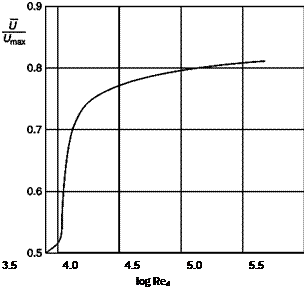Mass flow measurement by the velocity profile
The mass flow can be determined, by definition, by integrating the distribution of speed in a section of the duct. If the static pressure is constant in each section, it can be measured in a tap on the wall; to know the distribution of velocity it is sufficient to measure the distribution of stagnation pressure.
It is sufficient to introduce a Pitot tube in the duct through the wall and to explore a whole diameter. The exploration should also be repeated along a diameter orthogonal to the first. The method is laborious and unsuitable for routine work but has a high degree of accuracy and should be applied when calibrating a flowmeter. The procedure can be simplified if, as in all practical cases, the flow in the duct is fully developed: under these conditions the average velocity can be determined by measuring the speed on the axis and knowing the relationship existing between the average speed and the speed on the axis (Figure 2.34) which is a function of Reynolds number referred to the diameter of the duct: this ratio is 0.5 in laminar flow and increases to about 0.8 in the turbulent regime.
![]()
 |
Ratio between average and maximum speed in a tube as a function of the Reynolds number
Because the Reynolds number is not known a priori, it is necessary to follow an iterative process:
1. Assume a Reynolds number.
2. Read in Figure 2.34 the corresponding ratio between the average speed and the speed on the axis.
3. Measure the speed on the axis.
4. Calculate the average speed.
5. Calculate the Reynolds number.
6. Start again from step 2 until the speed difference between two consecutive iterations is less than the desired approximation.
Since in usual industrial applications the motion is always turbulent, Preston devised an instrument consisting of a tube with a constant section in which four Pitot tubes are placed at intervals of 90° on a circle whose radius is 3/4 of the radius of the pipe; four static taps are made on the wall corresponding to the heads of the Pitot tubes (Figure 2.35). The idea is that at 3/4 of the radius the speed is a constant fraction of the average speed in a wide range of Reynolds numbers and surface roughness.
Figure 2.35
|
The Preston tube
|
|
>
|
The Preston tube is an ideal instrument to measure the flow in a duct connected to a pumping system of limited power because inherent losses are negligible.













